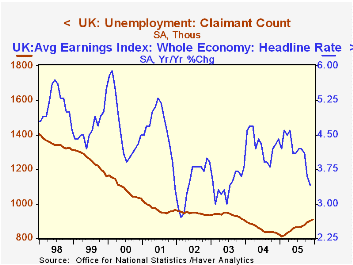 Global| Jan 18 2006
Global| Jan 18 2006UK Labor Market Weakens in Late 2005
Summary
Employment has begun to falter in the UK, according to the latest Labor Force Survey, published today by the Office of National Statistics (ONS). In the 3 months centered on October, the number of people employed fell 49,000 from [...]

Employment has begun to falter in the UK, according to the latest Labor Force Survey, published today by the Office of National Statistics (ONS). In the 3 months centered on October, the number of people employed fell 49,000 from September's 3-month average and stood only 0.8% above a year ago. As recently as August the year-on-year gain was 1.3%. The employment rate decreased 0.2 percentage points in the October reading to 74.5% from 74.7% in September and 74.8 in the October period of 2004. This rate, the number employed compared to the population of "working age" (16-59 for women and 16-64 for men), peaked at 75.0% last January. Commensurately, the unemployment rate has risen, reaching 5.0% most recently, up from a low of 4.7% recorded in August.
Associated wage and unemployment insurance data also show softening. The average earnings index, watched by many in the UK as a harbinger of inflation pressures, had just a 3.4% yearly growth rate in the three months ended November, slowing from 4.6% as recently as April. The number of claimants for Jobseeker's Allowance benefits rose in the month of December to 909,100 from 901,900 in November and 825,000 in December 2004.
There are other scattered signs of softening in the UK. Consumer confidence turned negative in October, and industrial production declined irregularly through much of 2005. The CBI industrial trends survey shows marked declines in order books continuously since March. GDP growth slowed to below 2% year-on-year in Q2 and Q3. [Q4 data are due to be reported next Wednesday, January 25.] Exports, by contrast, have been rising as have retail sales. So there is some mixed quality to UK economic activity, but the basic industry appears sluggish and it's hardly surprising that the labor market is sharing in this.
| UK Labor Force Survey (SA) | Dec 2005 | Nov 2005 | Oct 2005 | Sept 2005 | Year Ago | 2004 | 2003 | 2002 |
|---|---|---|---|---|---|---|---|---|
| Employment (Thous) | -- | -- | 28,764 | 28,813 | 28,542 | 28,465 | 28,183 | 27,917 |
| Change (Thous/%) | -- | -- | -49 | -12 | 0.8 | 1.0 | 1.0 | 0.8 |
| Employment Rate (%) | -- | -- | 74.5 | 74.7 | 74.8 | 74.8 | 74.6 | 74.5 |
| Unemployment Rate (%) | -- | -- | 5.0 | 4.9 | 4.7 | 4.8 | 5.0 | 5.2 |
| Average Earnings Index (Yr/Yr %) | -- | 3.4 | 3.6 | 4.1 | 4.3 | 4.3 | 3.4 | 3.5 |
| Claimant Count (Thous) | 909.1 | 901.9 | 891.5 | 878.0 | 825.0 | 853.6 | 933.3 | 946.7 |
Carol Stone, CBE
AuthorMore in Author Profile »Carol Stone, CBE came to Haver Analytics in 2003 following more than 35 years as a financial market economist at major Wall Street financial institutions, most especially Merrill Lynch and Nomura Securities. She had broad experience in analysis and forecasting of flow-of-funds accounts, the federal budget and Federal Reserve operations. At Nomura Securities, among other duties, she developed various indicator forecasting tools and edited a daily global publication produced in London and New York for readers in Tokyo. At Haver Analytics, Carol was a member of the Research Department, aiding database managers with research and documentation efforts, as well as posting commentary on select economic reports. In addition, she conducted Ways-of-the-World, a blog on economic issues for an Episcopal-Church-affiliated website, The Geranium Farm. During her career, Carol served as an officer of the Money Marketeers and the Downtown Economists Club. She had a PhD from NYU's Stern School of Business. She lived in Brooklyn, New York, and had a weekend home on Long Island.





